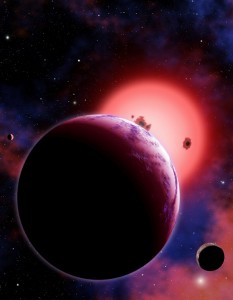There’s so much we still don’t know about GJ 1214b. What we do know is this: The planet is 2.7 times the size of Earth and about 6.5 times as massive, orbiting its star at a distance of 0.014 AU. That’s far too close to the primary to make this a habitable world, but a planet hardly has to be habitable to be interesting, and GJ 1214b becomes interesting indeed now that Jacob Bean (Harvard-Smithsonian Center for Astrophysics) has announced the first analysis of its atmosphere. Until now, we’ve been looking at exoplanet atmospheres only around larger worlds.

Super-Earths are generally considered to range from two to ten Earth masses. To study this one, the researchers used the Very Large Telescope at Paranal Observatory (Chile) to examine the near-infrared (780 to 1000 nanometers) region of the spectrum. More work at different wavelengths will be needed to tease out GJ 1214b’s secrets, but the progression in atmospheric observations to smaller planets is satisfying to see, as David Charbonneau (CfA) notes:
“In less than 10 years, we’ve gone from studying the atmospheres of alien worlds like Jupiter, to Neptunes, to super-Earths. Earth-sized worlds are next, although they’ll be the most difficult.”
That last goes under the category of heroic understatement, but there’s no question that studying the spectrum of a true Earth analog is one of the great goals of exoplanetary science, one that may tell us whether or not life exists on the world under study. Until then, we can take heart from this first analysis of a super-Earth atmosphere, which turned up a basically featureless spectrum. That ruled out a cloud-free atmosphere dominated by hydrogen, but it leaves open a hydrogen-rich atmosphere cloaked by a thick blanket of clouds or haze.
Image: The extrasolar planet GJ 1214b, shown here in an artist’s conception with two hypothetical moons, orbits a red dwarf star 40 light-years from Earth. Astronomers have confirmed that the planet has a thick atmosphere, but can’t yet determine whether the atmosphere is primarily hydrogen or a steamy soup of water vapor. Credit: David A. Aguilar (CfA).
A possible alternative: A dense and steamy atmosphere loaded with water vapor. Says Bean:
“A steamy atmosphere would have to be very dense — about one-fifth water vapor by volume — compared to our Earth, with an atmosphere that’s four-fifths nitrogen and one-fifth oxygen with only a touch of water vapor. During the next year, we should have some solid answers about what this planet is truly like.”
The CfA team looks to have produced rock-solid work — Drake Deming (NASA GSFC) is quoted in Nature as saying he was ‘stunned by the quality of their data.’ Further observations in the mid- or far-infrared are needed to differentiate between the two models, which means this exciting research leaves open as many questions as it answers. Bean says the planet is ‘veiling its true nature from us,’ an accurate assessment that only energizes the search for more data.
We’ve found gases like hydrogen and sodium vapor in the atmospheres of ‘hot Jupiters’ by studying transits as the planet passes between the star and Earth, allowing us to see at what wavelengths the star’s light is absorbed. The resulting chemical signature lets us break down the atmosphere of a planet we cannot directly see. GJ 1214b, which transits its star for fifty minutes out of every 38-hour orbit, has now opened a passage into super-Earth atmosphere studies that will soon be well traveled.
The paper is Bean et al., “A ground-based transmission spectrum of the super-Earth exoplanet GJ 1214b,” Nature 468 (2 December 2010), pp. 669-672 (abstract).



A wet-Venus, eh?
Seem to be a couple of studies of this planet which seem to come to fairly different conclusions, one claiming clear evidence of hydrogen. This should be interesting…
All other things being equal, there should be actually more hydrogen then Venus. The heavier gravity means that the planet should be able to better retain and capture any hydrogen or helium during the formation process. Maybe a water world (or a steam world if the planet is closer to the sun) as a super-earth is not implausible.
Just remember – be prepared to be surprised. People originally thought that Jupiter’s moons would be frozen ice balls with nothing interesting – the reality with moons like Io and Europa proved quite different. It’s likely that if it can form, there’s a planet somewhere out there in the universe with the characteristics, so we can expect a lot of diversity.